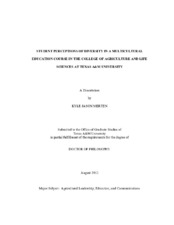| dc.contributor.advisor | Larke Jr., Alvin | |
| dc.creator | Merten, Kyle | |
| dc.date.accessioned | 2012-10-19T15:30:20Z | |
| dc.date.accessioned | 2012-10-22T18:00:20Z | |
| dc.date.available | 2014-11-03T19:49:13Z | |
| dc.date.created | 2012-08 | |
| dc.date.issued | 2012-10-19 | |
| dc.date.submitted | August 2012 | |
| dc.identifier.uri | https://hdl.handle.net/1969.1/ETD-TAMU-2012-08-11596 | |
| dc.description.abstract | Over the past 30 years, the population of Texas has continued to grow and become diverse. Undergraduate students at Texas universities preparing to enter the workforce will be faced with working more in diverse environments than those of their parents and grandparents. The purpose of this study was to determine overall student perceptions of diversity in a Multicultural Education course within the College of Agriculture and Life Sciences.
The research design used in this study was a one-group pretest-posttest design, with a follow-up retrospective post evaluation at the conclusion of the study to ascertain differences between the pretest and posttest administrative types. The target population consisted of all junior and senior classified students enrolled in ALED 422: Cultural Pluralism in Agriculture for the 2011 fall semester. A purposive convenience sample was taken for the study. During the study 47 students completed the pretest portion while 45 completed posttest and retrospective posttest portion of the study. Two of the participants were lost to attrition. Descriptive statistics were used for reporting the demographics of respondents. Mean scores and frequencies were used to assess students' perceptions of contributions in agriculture and diversity.
The sample consisted of 70.20% males and 29.80% females. The ethnic breakdown of the sample was 74.50% White (non-Hispanic), 10.60% Hispanic, 8.50% African American (non-Hispanic), 4.30% Other, and 2.10% Native American. Based on grand mean pretest (M = 3.82, SD = .56) and posttest (M=4.29, SD =.55) findings, results confirm the implementation of a multicultural education course were effective in changing students' perceptions about contributions in agriculture and diversity perceptions. Ten of the fourteen (71.43%) statements were found to have statistically significant differences between pretest and posttest measurements. Based on grand means for the pretest (M = 3.84, SD = 1.04) and posttest (M=4.29, SD =1.15), results confirm the implementation of a multicultural education course to discuss contributions in agriculture were effective in changing students' perceptions about contributions in agriculture. No statistically significant differences were found in age, permanent residence, and size of graduating class related to students' perceptions of diversity. Also, no statistical significant difference was found in the administration of a pretest and posttest versus a retrospective posttest. | en |
| dc.format.mimetype | application/pdf | |
| dc.language.iso | en_US | |
| dc.subject | Agriculture Education | en |
| dc.subject | Multicultural Education | en |
| dc.subject | Higher Education | en |
| dc.title | Student Perceptions of Diversity in a Multicultural Education Course in the College of Agriculture and Life Sciences at Texas A&M University | en |
| dc.type | Thesis | en |
| thesis.degree.department | Agricultural Leadership, Education, and Communications | en |
| thesis.degree.discipline | Agricultural Leadership, Education, and Communications | en |
| thesis.degree.grantor | Texas A&M University | en |
| thesis.degree.name | Doctor of Philosophy | en |
| thesis.degree.level | Doctoral | en |
| dc.contributor.committeeMember | Lockett, Landry L. | |
| dc.contributor.committeeMember | Boleman, Chris T. | |
| dc.contributor.committeeMember | Larke, Patricia J. | |
| dc.type.genre | thesis | en |
| dc.type.material | text | en |
| local.embargo.terms | 2014-10-22 | |


